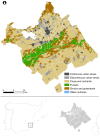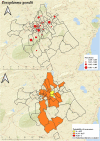Urban landscape and infection risk in free-roaming cats
- PMID: 35129882
- PMCID: PMC9304129
- DOI: 10.1111/zph.12919
Urban landscape and infection risk in free-roaming cats
Abstract
Despite public concern on the role of free-roaming cats as reservoirs of zoonotic agents, little is known about the influence of urban and peri-urban landscapes on the exposure risk. We evaluated the seroprevalence of three zoonotic agents (Chlamydia felis, Coxiella burnetii and Toxoplasma gondii) in domestic cats (Felis catus). Two hundred and ninety-one free-roaming cats were trapped in Murcia municipality (Southeast Spain), and their sera were tested for specific antibodies against T. gondii using a modified agglutination test (MAT), and for C. felis, C. burnetii and feline immunodeficiency virus (FIV) antibodies with ELISA technique. Pathogen seroprevalence at 95% CI was calculated for each sex and age category (up to and over 12 months) and compared with a chi-squared test. The role of human population density and urban landscape characteristics on the risk of pathogen exposure in the cat population was explored using generalized linear models. Seropositivity against a single pathogen was found in 60% of the cats, while 19% was seropositive for two or three pathogens. Seroprevalence of C. felis was 8% (CI95% : 5-11), 37% (CI95% : 31-42) for C. burnetii and 42% (CI95% : 36-47) for T. gondii. In addition to these three pathogens, FIV seropositivity was low (1%, CI95% : -0.1 to 2) and adult cats were more likely to be seropositive to C. burnetii than young individuals (OR: 2.3, CI95% : 1.2-4.2). No sex or age class differences in seroprevalence were observed for the rest of the pathogens. Seropositivity was correlated with water surface areas for C. felis, and not with crop areas. Coxiella burnetii seropositivity was correlated with the percentage of urban areas (continuous with only buildings and discontinuous, that include buildings, parks, and pedestrian and urban green areas), human population size and peri-urban areas with shrubs, and not correlated with other agricultural landscapes (orchards and crop areas). However, the seroprevalence of T. gondii was only associated with agricultural landscapes such as orchards. The detection of hotspot areas of high pathogen exposure risk is the basis for municipal services to implement surveillance and risk factor control campaigns in specific-risk areas, including (a) efficient health management of urban cat colonies by geographical location, population census and health status monitoring of the components of each cat colony, (b) improvement of hygiene and sanitary conditions at the feeding points of the cat colony and (c) free-roaming cat trapping for health monitoring and, in the long term, to know the evolution of the health status of their populations.
Keywords: Chlamydia felis; Coxiella burnetii; Toxoplasma gondii; free-roaming cat; geo-epidemiology; landscape, urbanization, rural area.
© 2022 The Authors. Zoonoses and Public Health published by Wiley-VCH GmbH.
Conflict of interest statement
The authors declare no conflict of interest.
Figures





References
-
- Afonso, E. , Lemoine, M. , Poulle, M.‐L. , Ravat, M.‐C. , Romand, S. , Thulliez, P. , Villena, I. , Aubert, D. , Rabilloud, M. , Riche, B. , & Gilot‐Fromont, E. (2008). Spatial distribution of soil contamination by Toxoplasma gondii in relation to cat defecation behaviour in an urban area. International Journal of Parasitology, 38, 1017–1023. 10.1016/j.ijpara.2008.01.004 - DOI - PubMed
-
- Akaike, H. (1973). Information theory and an extension of the maximum likelihood principle. In Petrov B. N., & Csaki F. (Eds.), Proceedings of the 2nd international symposium on information theory (pp. 267–281). Akadémiai Kiadó.
-
- Arjona, A. , Escolar, E. , Soto, I. , Barquero, N. , Martin, D. , & Gomez‐Lucia, E. (2000). Seroepidemiological survey of infection by feline leukemia virus and immunodeficiency virus in Madrid and correlation with some clinical aspects. Journal of Clinical Microbiology, 38, 3448–3449. 10.1128/JCM.38.9.3448-3449.2000 - DOI - PMC - PubMed
-
- Aronson, M. F. J. , Lepczyk, C. A. , Evans, K. L. , Goddard, M. A. , Lerman, S. B. , MacIvor, J. S. , Nilon, C. H. , & Vargo, T. (2017). Biodiversity in the city: Key challenges for urban green space management. Frontiers in Ecology and the Environment, 15, 189–196. 10.1002/fee.1480 - DOI
Publication types
MeSH terms
Substances
Supplementary concepts
LinkOut - more resources
Full Text Sources
Miscellaneous

